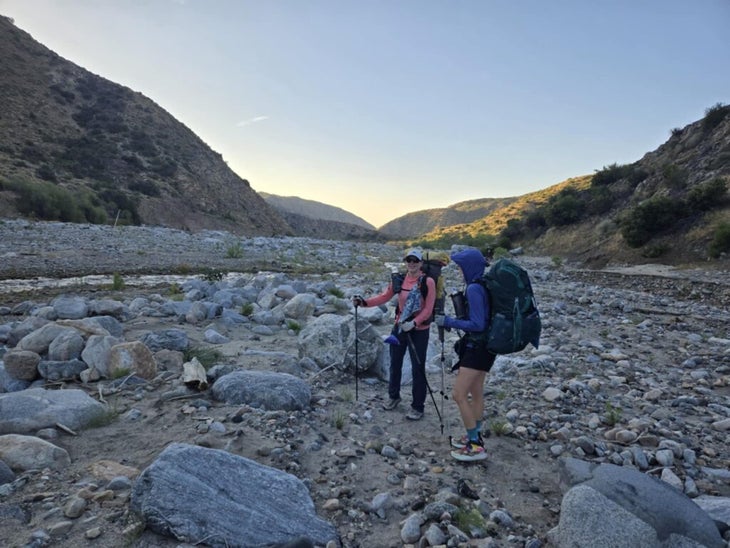Heading out the door? Read this article on the new Outside+ app available now on iOS devices for members! Download the app.
At Mission Creek, just over 200 miles from the southern terminus of the PCT, the trail disappears under a jumble of sand and boulders. The section has been a headache for Pacific Crest Trail thru-hikers since flooding washed away swaths of tread in 2023, and it’s proving especially difficult this year. According to the non-profit that looks after the trail, federal funding cuts mean it won’t be fixed any time soon.
“Torrential floods rearranged the entire section,” says Joe Clark, a repeat thru-hiker who has traversed Mission Creek in four of the past five years. “Parts of the trail that existed in 2021 and 2022 are completely gone now.” In 2021, Clark said he night-hiked through Mission Creek without a misstep. This year, the section was an anxiety-inducing combination of scrambling and route-finding. Attempting to follow the official trail on a paper map or navigation app like FarOut could leave hikers lost or stranded. In one case, a woman attempting to follow the trail near Mission Creek required a cliffside helicopter rescue. Clark managed to pick his way through the area, but only after shimmying across logs and boulders and wasting two hours hiking up the wrong side canyon.
“There are some incredibly dangerous scrambles across downed trees and boulders,” he says. “I was sketched out.”
Mission Creek is just one section that the Pacific Crest Trail Association has highlighted as an area of concern in 2025. Hikers face a rotating list of challenges each year as wildfires, landslides, and washouts reshape the trail corridor. Increasingly, a true end-to-end hike is nearly impossible, as impassable sections and wildfires force hikers to find detours. According to the Pacific Crest Trail Association, the trail will likely be especially difficult to navigate this year, as staffing and funding cuts at federal agencies cause a backlog of maintenance projects.
Mission Creek, for example, was due for a large-scale reroute, with work set to begin this year. That project has been cancelled, along with most PCTA-sponsored maintenance outside of volunteer trips. Other sections that will go without much-needed maintenance include Washington’s Glacier Peak Wilderness, along with several wildfire burn scars in Oregon and northern California.

Over the past year, the federal agencies that manage long-distance trails have faced severe cuts. Last fall, the U.S. Forest Service announced that it would not hire 2,400 seasonal employees in 2025 after Congress approved a smaller budget than the agency had hoped for. Earlier this year, the Trump administration’s Department of Government Efficiency took aim at both the Forest Service and the National Park Service, firing thousands of probationary employees, a move that opponents are currently challenging in court.
Trail organizations like the PCTA are also feeling the cuts. Facing economic uncertainty due to frozen federal funds, the nonprofit cancelled plans to hire six trail crew staff for the 2025 season. Cuts to Americorps funding have also had an impact. In 2024, the PCTA employed conservation corps crews for about 19,000 hours of trail work. This year, that number will be just 4,000 hours.
“Our program and field staff have pivoted their efforts to focus more on supporting local volunteer trail maintenance efforts,” says Chris Rylee, director of communications at the PCTA.
But according to those volunteers, cuts at agencies like the Forest Service will affect even their work. Susan McDonnell, a volunteer crew leader in the Mt. Hood area, says that she is already seeing the downstream effects of layoffs.
“Our partners have a lot more on their plate right now,” she says. “They’re trying to keep the bathrooms clean and the facilities open. They have less time to focus on trails.” At Mt. Hood National Forest, McDonnell says that there were about six Forest Service trail workers that would provide support to volunteer crews. This year, only the trails manager—an office-based position—remains.
“They’re marvelous partners,” says McDonnell. “The loss of their expertise is huge. The loss of their support is huge.”
Volunteers like McDonnell, who has been a trip leader for eight years, rely on the Forest Service to approve projects, wrangle supplies, and oversee any particularly technical or dangerous work.
“We had a tree that fell off of a cliff and took the trail out with it. It left a hole that was 20 feet long by 15 feet deep,” says McDonnell. The fix required tons of gravel, the construction of a gabion wall, and the expertise of a long-time Forest Service trail worker. “He provided the materials, the technical know-how,” McDonnell says. “And now he’s gone.”
Still, McDonnell has no plans to scale back their efforts this year, and hopes to recruit more volunteers to fill in the gaps.
“There’s a lot of work to do, especially in burn areas from wildfires in 2017 and 2021,” she says. “With the volunteers we currently have, I don’t think we’ll be able to get through all the logout work we are seeing this year. But with more help, it’s a possibility.”
